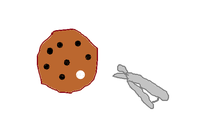Cookie clicker
“This article is about a video game released in 2013.”
A cookie clicker is a tool designed specifically in order to "click" cookies, punching holes into them. Cookie clickers, since their initial invention in the 1970s, have been used for a variety of purposes in the kitchen, including clicking cookies (their original purpose), making cucumber and steak skewers, and making ring-shaped dessert toppings.
Mechanism[edit | edit source]

A typical cookie clicker has a long lever which is used to push a bladed cylinder, the clicker, straight through cookies up to 1/2 an inch in thickness, and then through a close-fitting hole in the die. As the vertical travel distance of the cylinder is less than an inch, it can be positioned within about 1.2 inches of the lever fulcrum. For smaller cookie clickers, meant to slice through thinner, Subway-style cookies, the resulting lever need not be more than 3 inches for sufficient force.
The clicker's diameter generally varies between each clicker; a hole size of 1/4 inch allows for a a donut-shaped 3/4-to-1 inch cookie, whilst a 1/2 inch hole is generally favored for medium-sized cookies. Occasionally, a 1-inch hole is used for larger cookies and other foodstuffs (such as steak).
History[edit | edit source]
Invention[edit | edit source]
The cookie clicker's predecessor, the paper hole punch, was invented in 1885. However, the idea of bringing this idea of "clicking" thin objects did not come to cookies until 1968. An almost-thirty-year-old stockbroker, Martha Stewart, looking at the sheer mess that her kitchen has become and thinking of ways to transpose ideas from the office to the oven, thought of punching cookies as a means to allow them to bake faster. Initially, she used a simple office hole puncher on a typical sheet of cookie dough, but soon found out that a simple hole puncher could not click through the dough, owing to it being a much harder material than paper. Later, she developed the first prototype of what would become the cookie clicker; a 12-inch bolt cutter, modified to hold two flat steel disks, one with spikes and another with a small container where cookie remnants could be collected. Despite its bulky size being unsuitable for the kitchen, it worked well, and enabled her cookies to cook almost twice as fast. Seeing a possibility to commercialize said idea, Stewart then started designing the first cookie clicker.
The first commercialized cookie clicker was a simple variation on a stainless steel-based hole puncher, albeit significantly larger; this version had a 1/2-inch puncher which could slice through cookies up to 3/8-inch in size. This initial model was not extremely precise, owing to it lacking a guide to indicate where the hole would end up presenting itself; it also required frequent lubrication with vegetable oil, owing to its use of steel gears. A later revision would introduce a cheaper system which did used more efficient gears.
Developments[edit | edit source]
The cookie clicker, owing to itself being a basic kitchen tool, saw very few developments since its invention, apart from refinements and attempts at making it cheaper. Once, a plastic cookie clicker was attempted, but it just simply couldn't click the cookies well; who knew that plastic knives aren't as good as steel ones?
One notable development which occurred in 2013 was the introduction of a cursor. Initial versions of this tool, in the shape of a triangle attached to the clicker itself, would present exactly where the cookie would land. However, this system had a flaw: it could only show the center of the desired hole, and the cursor had to be retracted whenever the clicker was used. Whenever one would fail to retract the cursor, this would leave a triangle-shaped inprint on the cookie itself, with the cookie itself failing to be clicked because of the space required for the cursor.
A few years later, in 2016, a new iteration of the cursor was formed; a laser projector attached to the edges of the clicker's puncher. This would appear as a ring on the cookie as it is being prepared to be clicked; this enabled, for the first time, accurate cookie clicking. One downside to such a system is how it required electrical power; as such, nowadays, cookie clickers generally tend to come with a solar power receptacle and a leaky yet rechargeable battery.
Reception[edit | edit source]
Initially, when the first cookie clicker was introduced by Martha Stewart, it was deemed a "resounding innovation that enabled faster cooking for cookies". However, critics were dismayed at how specialized the tool was. One critic deemed it "the least useful invention of the decade", tied with the Apple I home computer.
Cookie clickers were mostly limited to niche usage prior to the 1990s, owing to how it only really did one thing. However, once people discovered that a cookie clicker could be used to click other thinly sliced things, or even thicker slices, its popularity increased significantly.
Nowadays, cookie clickers can be found in most kitchens. Alongside the can opener and a variety of other single-purpose tools, it enables doing something which otherwise wouldn't be possible, even with a precision knife.